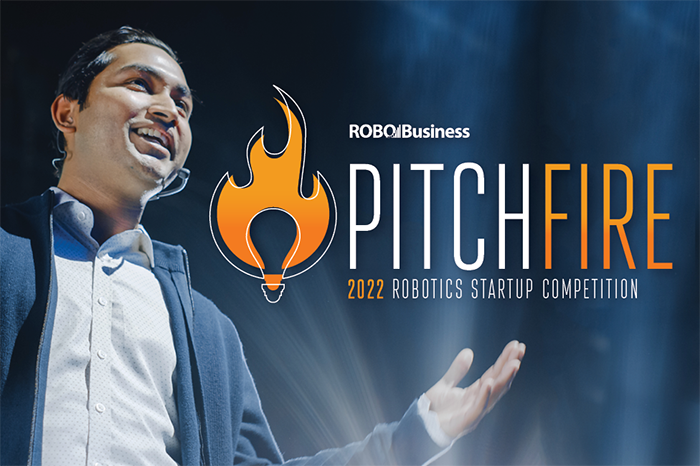|
Listen to this article  |

The Pitchfire startup competition has been an opening-day highlight for 10 years now at RoboBusiness, which runs Oct. 19-20 in Santa Clara, Calif. Pitchfire, which runs Oct. 19 from 5-6 PM at the Santa Clara Convention Center, is a must-attend event for investors, robotics entrepreneurs and innovation leaders alike. Attendees get a first glimpse at cutting-edge technologies from robotics’ most exciting emerging companies, and the opportunity to forge new commercial partnerships.
This year five robotics startups will compete. Each startup gets five minutes to describe their company’s solution, business model, value proposition and more. After all the contestants have pitched, Pitchfire judges will compare notes, come to a consensus, and announce a winner based on who they believe to be best primed for commercial success.
Andra Keay, Managing Director of Silicon Valley Robotics, will be the emcee of the event.
Companies that have previously competed in Pitchfire include Southie Autonomy, Sadako Technologies, Autonomous Marine Systems, inVia Robotics, Catalina Health, Cubit, Rokid, RightHand Robotics, Soft Robotics and Knightscope.
Here is a look at this year’s participants:
FLX Solutions
Location: Bethlehem, Pa.
Website: https://www.flxsolutions.com/
FLX Solutions is developing robots that are miniaturized to operate in spaces that humans and traditional robots cannot easily access. Its first product, FLX BOT is a patented, snake-like robot that is 1 inch in diameter and expands, braces, and climbs to perform many customizable actions.
The modular robot is made up of identical, interchangeable links that each have a camera and sensor to enable 3D mapping and autonomous navigation. Each robot has interchangeable end effectors including drills, grippers, vacuums or sprayers.
FLX BOT will initially target the cable/telecom, manufacturing, and construction/plumbing industries, and will partner with large companies in other industries to license its IP.
Raise Robotics
Location: San Francisco, Calif.
Website: https://raiserobotics.ai
Raise Robotics creates robots that build and maintain the world’s physical infrastructure. Its first product is a dual-arm mobile manipulator that completes high-precision installations of fastened components for new commercial building construction, helping customers improve safety and efficiency. Raise Robotics is working with some of the largest construction companies in the world to bring its product to market and has started pilots with customers.
Its customers have challenges completing projects due to labor shortages and low productivity. Its robot solves these problems by completing installations faster than humans can (4x speed increase) while reducing the number of people required to do the job, resulting in an estimated 50% cost savings. The first two use cases Raise Robotics is supporting are installing brackets for unitized curtain wall building facades and for cross-laminated timber buildings.
Tatum Robotics
Location: Boston, MA
Website: https://tatumrobotics.com
For most deaf-blind individuals, communication with others is reliant on human, in-person interpreters. While some deaf-blind people are proficient with braille, the majority are not, and they must depend on professionals to engage with media, education, medical settings, social settings with non-signers, etc. This dependence leads to under-stimulation, loneliness, and a lack of privacy.
Tatum Robotics’ first-of-its-kind system will allow the deaf-blind community to access information, entertainment, and connection at their convenience and in their primary language. Where former assistive technology focuses on braille, Tatum’s system would prioritize the language needs of the target customer, who communicates using tactile signing.
Tatum’s solution consists of an original hardware and software design. Tatum uses machine learning to translate from English to tactile American Sign Language. The company offers two products: the Fingerspelling T1 and the Signing T1. These anthropomorphic devices will allow deaf-blind users to directly access communication from several mediums, including books, email, and relay services.
Transitive Robotics
Location: Menlo Park, Calif.
Website: https://transitiverobotics.com/
Transitive is an open-source framework and service for full-stack robotic capabilities. The framework connects robots, the cloud, and web UI components via a proprietary data-synchronization protocol built on MQTT. Its architecture is modular such that each capability can be used and purchased by itself and embedded into any other web application.
Every robotics company that operates more than a handful of robots needs some sort of cloud layer to which all their robots connect and via which many critical functions can be performed, be it for fleet management, syncing data to user interfaces, or operation. However, unlike in the robotics layer where ROS has drastically accelerated robotics software development, for this cloud layer there is no existing framework that robotics companies can readily adopt, build upon, and extend. Transitive is that missing layer.
Transitive’s business model is similar to Android: the framework is free and open-source, but apps called “capabilities” or “caps” can be premium. Additional revenue opportunities arise from hosting fees.
Vici Robotics
Location: San Jose, Calif.
Website: https://www.vicirobotics.com
U.S. brick-and-mortar retailers are experiencing a crippling labor shortage resulting in empty shelves and shrinking margins. One way or another, products have to get on the shelves for retailers to survive, so the increased demand is driving wages unsustainably high in an industry that wasn’t built on big margins.
Vici is developing mobile robots that automate in-store labor hours by re-stocking shelves and picking e-commerce orders. The robots can mechanize the most significant labor expense in retail by picking up products, moving around a store, and placing a wide variety of goods in meaningful ways.
A single chain with 2,000 stores in the U.S. would result in an ARR of $900 million. There are 38,000 grocery stores in the U.S. and an average of 15 stockers per store, resulting in a market size of $24 billion just for grocery.
Credit: Source link


Comments are closed.